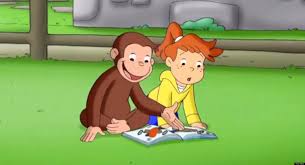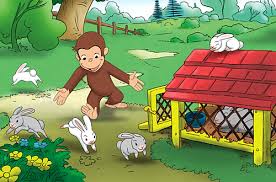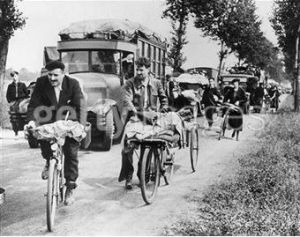~~~~~~~~~~~~~~~~~~~~~~~~~~~~~~~~~~~~~~
Key points:
- During their escape the couple had two close calls, but it was George who saved their lives.
- The authors' new life in America.
- George becomes famous.
- George's Jewish nature is in his character and his life story.
- Authors also wrote other books advocating for ethnic harmony.
- George was their only 'child'. A very young reader once told them he was disappointed because he expected them to be monkeys too.
By Saul Jay Singer
Who were Curious George's parents?
 |
| H.A. REY reading to children in the early 1970s. |
Born into a traditional Jewish family, Hans Augusto (“H.A.”) Reyersbach
(1898–1977) was a self-taught artist who at a young age developed a love for
animals and began sketching them at the famous Hagenbeck Zoo near his Hamburg
home.
After serving in the German army during World War I, he returned to
Hamburg and worked as a commercial artist, designing and lithographing circus
posters.
Facing difficult economic times in Germany, however, he traveled to
Brazil where, while selling goods along the Amazon River, he observed and
sketched monkeys in their natural habitat. Hans later worked on decorative maps
for the Brazilian Pavilion at the Paris World’s Fair (1937).
 |
| Margaret Waldstein (or Margret Rey) with her husband H.A. Rey in 1951 |
Margarete Waldstein (1906-1996) was the granddaughter of a prominent Hamburg
rabbi and the daughter of a Jewish member of the Reichstag, the German
parliament, in the 1920s.
She studied art and photography at the renowned
Bauhaus School and at the Dusseldorf Art Academy and, in the late 1920s, had a
solo exhibit of her watercolors in Berlin.
Sensitive to the rapidly changing political climate and having the foresight
to leave Germany as Hitler began his rise to power, she worked as a photographer
in London before traveling in 1935 to Rio de Janeiro where she ran into an old
family friend: Hans, who had first met her when she was ten years old and
sliding down a banister.
The two artists began working together, founded the
first advertising agency in Rio, married in August 1935, and changed the name
Reyersbach to the easier to pronounce “Rey.”
After honeymooning in Paris, the couple decided to remain there and settled
in Montmartre, a well-known French artists’ neighborhood, where they began
writing and illustrating books for children.
As Margret later explained, “We
loved monkeys…. Hans was the artist, a genius and a dreamer who loved animals. I
was the midwife. I’d write the text and supervise the drawings.”
Continue reading and see more images
 After their fateful escape from Paris and a four-month journey, the couple
finally reached New York in October 1940, where they used the rescued drawings
of George to establish their profession as artists and so to qualify for an
American visa. They became American citizens on April 8, 1946.
After their fateful escape from Paris and a four-month journey, the couple
finally reached New York in October 1940, where they used the rescued drawings
of George to establish their profession as artists and so to qualify for an
American visa. They became American citizens on April 8, 1946.
 The Man with the Yellow Hat, who remains
mysterious and anonymous, turns George into a refugee when he violently removes
George from his home in the African Jungle, where he had spent his days happily
swinging on vines with the other monkeys and eating bananas.
The Man with the Yellow Hat, who remains
mysterious and anonymous, turns George into a refugee when he violently removes
George from his home in the African Jungle, where he had spent his days happily
swinging on vines with the other monkeys and eating bananas.
 In all, the Reys authored and illustrated more than 30 books, most of them
for children, which have never been out of print for 70 years and have sold over
30 million copies.
In all, the Reys authored and illustrated more than 30 books, most of them
for children, which have never been out of print for 70 years and have sold over
30 million copies.
 Margret visited Israel in 1977 and some time before her death in 1996
wistfully said, “I didn’t do enough for Jews.”
Margret visited Israel in 1977 and some time before her death in 1996
wistfully said, “I didn’t do enough for Jews.”
George goes to the Hospital
Here is an extremely rare original signed ink drawing of an American icon and the world’s most beloved little monkey: H.A. Rey depicts Curious George dancing with a bouquet of flowers in his hand.
The sketch, on the verso of the front free endpaper of Curious George Goes to the Hospital is inscribed “For Nora/ with love from the Reys (and leave it at the Hospital, for other patients, if you want to.) / May 1971.”
Source
http://www.jewishpress.com/indepth/front-page/how-curious-george-escaped-the-nazis/2015/08/12/0/
Further references
H.A. Rey - Wikipedia
https://en.wikipedia.org/wiki/H._A._Rey
Margret Rey - Wikipedia
https://en.wikipedia.org/wiki/Margret_Rey
Fleeing Hitler - France 1940 - A book review
https://whenthenightcomesfallingfromthesky.wordpress.com/2010/12/03/book-fleeing-hitler-france-1940-why-people-run-away-in-war/
How was Curious George born?
The concept for Curious George began with a story about Raffy, a lonesome
giraffe who befriends nine monkeys, the youngest of whom is named Fifi.
By 1939,
having decided to narrow their tale to Fifi, the Reys were hard at work on
The Adventures of Fifi and another book about a penguin named
Whiteblack. As we will see, “Fifi” eventually became the Curious George we all
know and love.
Curious George and parents escape the Nazis as the German army marches into Paris
Curious George may never have even seen the light of day but for the
determination and courage of his creators.
 |
| Fleeing Hitler's advance into France |
The Reys had been living in Paris for
four years and, on June 14, 1940 – mere hours before the Nazis marched into
Paris – they fled on bicycles (so beloved to George) carrying only some warm
clothes, food, and some old drawings for their children’s stories, including one
about a certain mischievous monkey.
Due to the shortage of anything on wheels, as Parisians by the thousands were
fleeing the advancing German army, Hans had to assemble the escape bikes himself
from spare parts.
The Reys rode their bikes for four days until they reached the
border with Spain, where they sold the bikes to customs officials and used the
proceeds to purchase train fare to Lisbon, from where they sailed back to
Brazil. But the trip was not without its close calls.
Curious George saves his parents - twice
Not only were the Reys able to save George, but he actually saved them –
twice.
First, just prior to fleeing France, they were arrested as
suspected spies by the French police.
During their interrogation, an officer
came across their Curious George manuscript and, attempting to find evidence in
the book that would confirm them as spies, instead found himself enchanted by
the story of the little monkey.
Reasoning that the authors of such an innocent
children’s book could not possibly be spies, he released them, and Hans and
Margret were able – barely – to escape the Nazi invasion.
The Reys effected a similar narrow escape when a guard boarded the train at
the Spanish border, pulled them aside, and demanded to see the contents of their
satchel. No doubt expecting to find stolen documents or smuggled contraband, he
found the drawings of a delightful little monkey.
“My children would love this,” he said, before permitting them to continue on
their way. These events may explain why “being on the run” and “saving the day
after a narrow escape from danger” became a template for most the Curious George
stories.
Curious George and parents arrive in America
The Reys’ American publisher, Houghton Mifflin, was dubious about calling a
mischievous male monkey “Fifi,” so the name was changed to George by their
editor, Grace Hogarth.
The British objected to a monkey being called George
However, this name, too, became problematic when the book
was distributed in Great Britain, where the reigning sovereign was also named
George (King George VI).
Since it was deemed unduly irreverent, if not outright
disrespectful, to call a fictional monkey by the same name as a sitting British
monarch, George became “Zozo” in Britain when the first British edition was
published in London (1942).
George's many names all over the world
It’s interesting to note that George is called by
various other names throughout the world, including Coco (Germany), Peter Pedal
(Denmark), and Choni Ha-Sakran (Israel).
In the early 1940s, most children’s books were created by women, and the
publishers believed that releasing the Curious George books under Hans’s name
alone would help promote the books and increase sales. After the striking
success of the early Curious George books, however, Margret’s name was added and
the books began publication under both their names.
George's Jewish nature
While there is no literal Jewish content in the Reys’ work, Jewish
significance may nevertheless be found in the Curious George stories.
George
strives and ultimately prevails against adversity, much as the Reys struggle and
ultimately triumph against the Nazis.
But George survives being captured, trapped in a brown sack, and being exiled
from his home in Africa, and he ultimately adapts to his new country and his new
life.
He becomes fully integrated into the great American “melting pot” as he
takes a job, goes to Hollywood, visits the circus, goes to the hospital, and
even becomes the first animal in space, beating Laika – the Russian cosmonaut
dog who blasted off into space on Sputnik 2 on November 3, 1957 – by mere
weeks.
Similarly, Hans and Margret were refugees from the Nazis who adapted to their
new lives as American citizens.
According to some commentators, the yellow hat
worn by George’s abductor could be a reference to the yellow stars Jews were
forced to wear under the Nazi regime.
Additionally, in the original Curious
George book, the Man with the Yellow Hat helps George get all his identification
papers in order, in contrast to the Reys’ struggle to secure the necessary
papers to leave France.
Thus, the great poignancy and irony of the Curious George stories is that
while its creators crafted a child’s fictional world of hopefulness, innocence,
and resolute cheerfulness, readers did not know that the true underlying story
is one of a dramatic escape from the Nazis during the Holocaust and a tale of
Jewish survival.
George's many adventures become famous
George remains one of the most beloved and recognized characters in all of
children’s literature.
The first Curious George book, published in 1941, has
been translated into more than fourteen languages, including Yiddish and Hebrew,
and in 2007 a rare first edition of that book sold at auction for $21,850.
The original seven George books by Hans and Margret, together with the 28
sequels Margret wrote with the late Alan J. Shalleck after Hans’s death, have
sold about 30 million copies.
George has also been featured in a Public Service campaign in conjunction
with the Ad Council and the Library of Congress; was inducted into the Indie
Choice Book Awards Picture Book Hall of Fame; and has starred in an Emmy-Award
winning PBS television series and in at least three full-length films.
Whiteblack the Penguin Sees the World wasn’t
published until 2000, when the manuscript was rediscovered in the Rey archives
and published posthumously.
The authors also wrote books advocating for ethnic harmony
Though the Reys are best known for Curious George, they also published many
other stories, including a few that were well ahead of their time in addressing
racial matters and advocating for ethnic harmony, which undoubtedly grew out of
their own Holocaust experience.
For example, in Zebrology (1937), an adult book, the Reys humorously
trace the evolution of the zebra from both white and black horses. Arguing that
people can be different and still live together in harmony, the book humorously
ponders: “Is the zebra white with black stripes, or black with white
stripes?”
Similarly, the Reys address the issue of discrimination in Spotty
(1945), the story of a rabbit snubbed by friends and family because of his
unusual spotted fur. The book, which was praised by the Anti-Defamation League,
was translated into German as a teaching tool for the “re-education” program in
Germany instituted by the U.S. Army after World War II.
Hans also combined his interests in stargazing and drawing in two books about
astronomy: The Stars: A New Way to See Them (1952), written for adults,
and Find the Constellations (1954), a children’s version.
Other
children’s books by the Reys include Don’t Frighten the Lion (1942), in
which a resourceful poodle in girls’ clothes tours the zoo, and Elizabite –
The Adventures of a Carnivorous Plant (1942), in which all attempts to
prevent the hungry plant from filling his stomach’s desires
fail.
George was truly the Reys' baby
Though the Reys never had any children of their own, they became widely known
as “the parents of Curious George.”
Margret used to tell of the time she and
Hans met a little boy who stared at them with keen disappointment and said, “I
thought you were monkeys, too.”
Margret, who always loved children and animals, established the Curious
George Foundation (1989), which funds educational programs for creative – and
curious! – children and also supports organizations devoted to the prevention of
cruelty to animals and to their preservation.
However, through her Foundation,
she was a major supporter of Boston’s Beth Israel Deaconess Medical Center and
she bequeathed $2.5 million to Jewish charities, including a significant
contribution to the Combined Jewish Philanthropies of Greater Boston.
RELATED:
George goes to the Hospital
Here is an extremely rare original signed ink drawing of an American icon and the world’s most beloved little monkey: H.A. Rey depicts Curious George dancing with a bouquet of flowers in his hand.
The sketch, on the verso of the front free endpaper of Curious George Goes to the Hospital is inscribed “For Nora/ with love from the Reys (and leave it at the Hospital, for other patients, if you want to.) / May 1971.”
Curious George Goes to the Hospital (1966) was H.A. Rey’s final story before his death.
The story differed from the previous books in its attempt to be both educational and entertaining. George comes down with stomach pains after swallowing a puzzle piece and, taken to the children’s ward at the hospital, he meets other young children who also need medical attention. He decides to explore the hospital and, as usual, causes a commotion due to his curiosity.
Hans and Margret Rey collaborated with the Children’s Hospital Medical Center in Boston to familiarize children with hospitals, their procedures, and the people who work in them.
By presenting the hospital in a story with a comforting and familiar character like George, they hoped to ease some of the anxiety a child entering a hospital might have.
Margret later commented that “to my surprise, nobody in any country ever objected to the fact that a monkey . . . goes through the whole hospital routine.”
About the Author: Saul Jay Singer, a nationally recognized legal ethicist, serves as senior legal ethics counsel with the District of Columbia Bar. He is a collector of extraordinary original Judaica documents and letters, and his column appears in The Jewish Press every other week. Mr. Singer welcomes comments at saul.singer@verizon.net.
http://www.jewishpress.com/indepth/front-page/how-curious-george-escaped-the-nazis/2015/08/12/0/
Further references
H.A. Rey - Wikipedia
https://en.wikipedia.org/wiki/H._A._Rey
Margret Rey - Wikipedia
https://en.wikipedia.org/wiki/Margret_Rey
Fleeing Hitler - France 1940 - A book review
https://whenthenightcomesfallingfromthesky.wordpress.com/2010/12/03/book-fleeing-hitler-france-1940-why-people-run-away-in-war/


No comments:
Post a Comment
Thank you for visiting my blog. Your comments are always appreciated, but please do not include links.